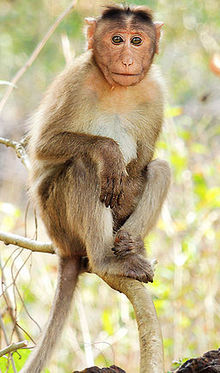
Back Мамун ADY ዝንዠሮ Amharic Lotong AMI बंदर ANP سعدان Arabic ܩܘܦܐ ARC قرد ARZ Monu AST Маймалак AV K'usillu Aymara
| Monkeys Temporal range:
| |
|---|---|

| |
| Bonnet macaque Macaca radiata
Mangaon, Maharashtra, India | |
| Scientific classification | |
| Domain: | Eukaryota |
| Kingdom: | Animalia |
| Phylum: | Chordata |
| Class: | Mammalia |
| Order: | Primates |
| Suborder: | Haplorhini |
| Infraorder: | Simiiformes [a] |
| Groups included | |
| Cladistically included but traditionally excluded taxa | |
Monkeys are tree-dwelling (arboreal) simians. They are in the primate order. Monkeys are intelligent, social animals. Monkeys have a tail, even if it is a short one.[2]
The word "monkey" is a common-language term. It includes two different groups of primates. The big difference is between Old World monkeys and New World monkeys. Some examples of monkeys are macaques, baboons, and guenons.
- Old World monkeys: Cercopithecidae. Apes are the descendants of Old World monkeys.[3]
- New World Monkeys: Platyrrhini or Ceboidea (same thing in effect)
Both groups are in the infraorder Simiiformes. That infraorder also includes the great apes and humans.[4]
The simians (monkeys) are a sister group to the tarsiers – the two members in the suborder Haplorhini diverged some 60 million years ago. New World monkeys and catarrhine monkeys appeared within the simians roughly 30 million years ago. Old World monkeys and apes emerged within the catarrhine monkeys about 70 million years ago.
- ↑ Groves 2008, pp. 92–93.
- ↑ "Monkey". kids.britannica.com. Retrieved 31 December 2010.
- ↑ Dawkins, Richard (2004). The ancestor's tale: a pilgrimage to the dawn of evolution. Houghton Mifflin Harcourt. p. 140. ISBN 9780618005833. Retrieved 2008-08-24.
- ↑ Fleagle, J.; Gilbert, C. Rowe, N.; Myers, M. (eds.). "Primate Evolution: John Fleagle and Chris Gilbert". All the World's Primates. Primate Conservation, Inc. Archived from the original on 12 May 2015. Retrieved 18 December 2014.
<ref group=lower-alpha> tags or {{efn}} templates on this page, but the references will not show without a {{reflist|group=lower-alpha}} template or {{notelist}} template (see the help page).